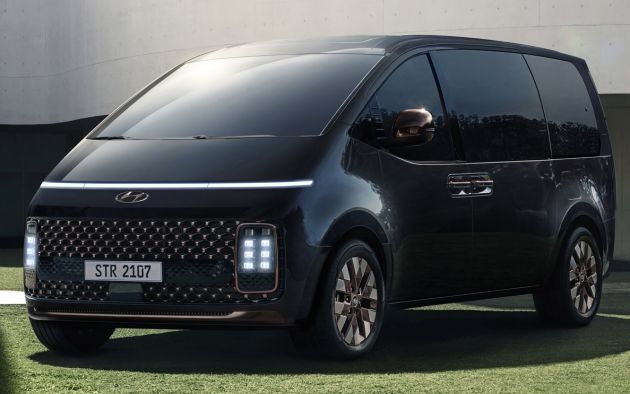Hyundai Staria detailed – Starex replacement is larger, gets 177 PS 2.2L diesel, 272 PS 3.5L petrol V6, AEB
Having already revealed the design of the Staria last month, Hyundai has released full information on its new van/MPV. Replacing the Starex, this model marks a sea change from its predecessor with a far more futuristic exterior and interior design.
We’ve already seen what the car looks like, but it’s still striking for such a utilitarian vehicle. The minimalist spaceship-esque design is defined by a single line running from the front end to the rear roof, which is said to be inspired by the curved outline of the Earth at sunrise when viewed from space.
The brutalist front end features a slim horizontal LED daytime running light strip that runs the full width of the car, under which sits a broad grille incorporating low-mounted vertical headlights. As standard, the Staria comes with a body-coloured grille for a more minimalist look, while Premium models get bronze accents on the emblem, grille, headlamp bezels, bumpers, wheels, side mirrors and door handles.
Along the side, the beltline sweeps downwards, making for big side windows that maximise outward visibility. The clean surfacing is only disturbed by the gentle wheel arch flares and the door handles. The rear end features a wide tailgate with a large windscreen, framed by vertical taillights. On the Premium models, these receive a Parametric Pixel design first seen on the Ioniq 5, plus matching garnishes on top.
The imposing look emphasises the Staria’s larger dimensions compared to the Starex – it measures 5,253 mm long (+103 mm), 1,997 mm wide (+77 mm) and 1,990 mm tall (+55 mm), with a 3,273 mm (+73 mm) wheelbase. Exterior colours include Abyss Black Pearl, Creamy White, Graphite Gray Metallic, Moonlight Blue Pearl, Shimmering Silver Metallic, Dynamic Yellow, Olivine Gray Metallic and Gaia Brown Pearl.
Continuing to be offered with two to 11 seats, the Staria’s interior – claimed to be inspired by a cruise ship – is just as forward-looking as the outside. The uncluttered dashboard is dominated by a freestanding touch-based control panel with a 10.25-inch infotainment screen, plus a high-mounted digital instrument display that looks suspiciously like Peugeot’s i-Cockpit layout.
The new infotainment system comes with a number of family-friendly features, including a camera for monitoring the rear occupants and a unique speaker system that allows for clearer communication between the front and rear passengers.
There’s also plenty of storage space available, including in the overhead console, at the bottom of the instrumentation and at the top and bottom of the centre fascia. A centre console with cup holders, USB ports and additional cubby holes is also fitted, while the glovebox has been pushed forward to give the front passenger more legroom.
Premium models get more goodies at the rear. Seven-seater models come with individual Premium Relaxation Seats that can slide fore and aft and come with a one-touch relaxation mode. This reclines the seat electrically and extends the ottomans, giving the car an almost business class-like feel.
Even in this mode, Hyundai says there is enough room for an adult to sit in the third row. Nine-seater models trade these plush pews for those that can rotate 180 degrees to face the third row. Other features exclusive to the Premium are standard-fit 64-colour ambient lighting and a Bose sound system.
The Staria also comes with long seat sliding rails to enable the seats to be pushed forward to increase luggage space, while standard models get a full-flat mode for the rear seats to stow longer cargo. For maximum load-lugging capability, the two- and three-seater van models offer nearly 5,000 litres of cargo space, with the load bay now made larger to fit three Euro pallets at once.
Both engine options come from the latest Smartstream family. The 2.2 litre four-cylinder turbodiesel comes with an improved turbocharger compressor and turbine wheel for increased low-end torque, producing 177 PS and 431 Nm of torque. It is mated to either a six-speed manual gearbox or an eight-speed automatic.
Also offered is a 3.5 litre naturally-aspirated MPI V6, equipped with a more efficient integrated roller swing arm, stainless steel casings and an integrated thermal management system for optimised coolant temperature control. It churns out 272 PS and 331 Nm of torque and is paired solely to the eight-speed auto.


Both powertrains have been optimised for refinement, shift sensation and acceleration, with the direct valve control body, oil pump and multi-plate torque converter also tweaked for greater efficiency. Under the skin, the Staria features a new multi-link rear suspension for a more comfortable ride, plus revamped dampers and brakes. The streamlined body also improves aerodynamic efficiency.
Safety-wise, the Staria is available with up to six airbags and three-point seat belts and headrests for all occupants, along with autonomous emergency braking and blind spot monitoring with steering intervention. Also fitted are seat belt reminders that operate via wireless communications (a world first, enabling the long seat sliding feature), a door opening warning and a rear seat reminder.
Moving forward, Hyundai will introduce “special vehicle” variants of the Staria, including limousines, ambulances and camper vans. Eco-friendly models will also be added further down the line, which we assume will be driven by electrified powertrains.










The post Hyundai Staria detailed – Starex replacement is larger, gets 177 PS 2.2L diesel, 272 PS 3.5L petrol V6, AEB appeared first on Paul Tan's Automotive News.
from Paul Tan's Automotive News
Read The Rest:paultan...






Post a Comment